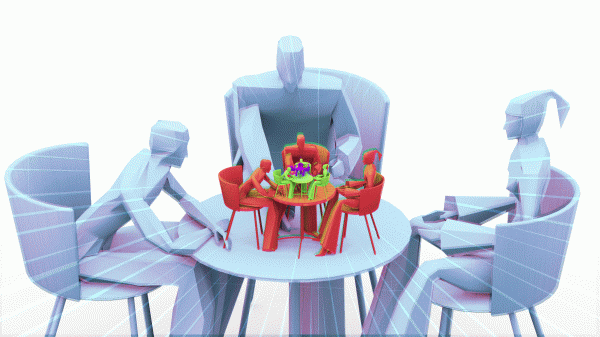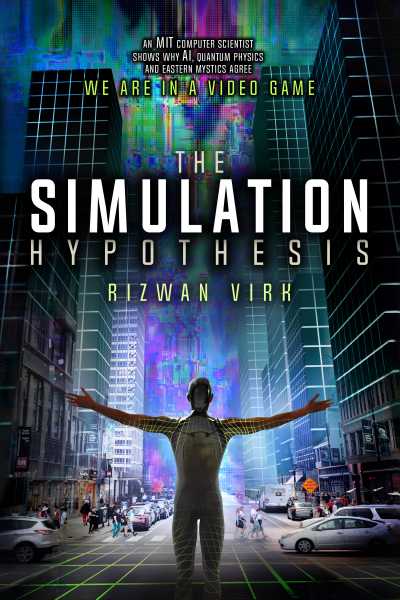
Are we living in a computer simulation? I don’t know. Probably.
Why this computer scientist thinks reality might be a video game.
By
Sean Illing@seanilling
Updated
Dec 27, 2019, 9:44am EST
Share this story
-
Share this on Facebook
-
Share this on Twitter
-
Share
All sharing options
Share
All sharing options for:
Are we living in a computer simulation? I don’t know. Probably.
-
Reddit
-
Pocket
-
Flipboard
-
Email
This story is part of a group of stories called

Finding the best ways to do good.
Are we living in a computer simulation?
The question seems absurd. Yet there are plenty of smart people who are convinced that this is not only possible but perhaps likely.
In an influential paper that laid out the theory, the Oxford philosopher Nick Bostrom showed that at least one of three possibilities is true: 1) All human-like civilizations in the universe go extinct before they develop the technological capacity to create simulated realities; 2) if any civilizations do reach this phase of technological maturity, none of them will bother to run simulations; or 3) advanced civilizations would have the ability to create many, many simulations, and that means there are far more simulated worlds than non-simulated ones.
We can’t know for sure which of these is the case, Bostrom concludes, but they’re all possible — and the third option might even be the most probable outcome. It’s a difficult argument to wrap your head around, but it makes a certain amount of sense.
Rizwan Virk, a computer scientist and video game designer, has just released a new book, The Simulation Hypothesis, that explores Bostrom’s argument in much greater detail and traces the path from today’s technology to what he calls the “Simulation Point,” the moment at which we could realistically build a Matrix-like simulation.
I know nothing about computer science, but this idea that we’re all characters in an advanced civilization’s video game is, well, kind of awesome. So I reached out to Virk and asked him to break it down for me.
A lightly edited transcript of our conversation follows.
Sean Illing
Pretend I know absolutely nothing about the “simulation hypothesis.” What the hell is the simulation hypothesis?
Rizwan Virk
The simulation hypothesis is the modern equivalent of an idea that’s been around for a while, and it is the idea that the physical world that we live in, including the Earth and the rest of the physical universe, is actually part of a computer simulation.
You can think of it like a high resolution or high-fidelity video game in which we are all characters, and the best way to understand it within Western culture is the movie The Matrix, which many people have seen, or even if they haven’t seen [it], it’s become a cultural phenomenon now beyond the film industry.
In that movie, Keanu Reeves plays the character Neo, who meets a guy names Morpheus, who is aptly named after the Greek god of dreams, and Morpheus gives him a choice of taking the red pill or the blue pill. And if he takes the red pill, he wakes up and realizes that his entire life, including his job, the building he lived in, and everything else, was part of this elaborate video game, and he wakes up in a world outside of the game.
That is the basic version of the simulation hypothesis.
Sean Illing
Are we living in a simulated universe right now?
Rizwan Virk
There are lots of mysteries in physics that are better explained by the simulation hypothesis than by what would be a material hypothesis.
The truth is that there’s much we simply don’t understand about our reality, and I think it’s more likely than not that we are in some kind of a simulated universe. Now, it’s a much more sophisticated video game than the games we produce, just like today World of Warcraft and Fortnite are way more sophisticated than Pac-Man or Space Invaders. They took a couple of decades of figuring out how to model physical objects using 3D models and then how to render them with limited computing power, which eventually led to this spate of shared online video games.
I think there’s a very good chance we are, in fact, living in a simulation, though we can’t say that with 100 percent confidence. But there is plenty of evidence that points in that direction.
Sean Illing
When you say there are aspects of our world that would make more sense if they were part of a simulation, what do you mean exactly?
Rizwan Virk
Well, there are a few different aspects, one of which is this mystery they call quantum indeterminacy, which is the idea that a particle is in one of multiple states and you don’t know that unless you observe the particle.
Probably a better way to understand it is the now-infamous example of Schrödinger’s cat, which is a cat that the physicist Erwin Schrödinger theorized would be in a box with some radioactive material and there was a 50 percent chance the cat is dead and a 50 percent chance the cat is alive.
Now, common sense would tell us that the cat is already either alive or it’s dead. We just don’t know because we haven’t looked in the box. We open the box and it’ll be revealed to us whether the cat is alive or dead. But quantum physics tells us that the cat is both alive and dead at the same time until somebody opens up the box to observe it. The cardinal rule is the universe renders only that which needs to be observed.
Sean Illing
How does Schrödinger’s cat relate to a video game or a computer simulation?
Rizwan Virk
The history of video game development is all about optimizing limited resources. If you asked somebody in the 1980s if you could you render a game like World of Warcraft, which is a full three-dimensional or a virtual reality game, they would say, “No, It would take all the computing power in the world. We couldn’t render all those pixels in real time.”
But what happened over time was that there were optimization techniques. The core of all these optimizations is “only render that which is being observed.”
The first big game to successfully do this was called Doom, which was very popular in the 1990s. It was a first-person shooter game, and it could render only the light rays and objects which are clearly visible from the point of view of the virtual camera. This is an optimization technique, and it’s one of the things that reminds me of a video game in the physical world.

Sean Illing
I’m going to do the thing that non-scientists always do when they want to sound scientific and invoke Occam’s razor. Isn’t the hypothesis that we’re living in a flesh-and-blood physical world the simpler — and therefore more likely — explanation?
Rizwan Virk
I’ll bring up a very famous physicist, John Wheeler. He was one of the last physicists who worked with Albert Einstein and many of the great physicists of the 20th century. He said that physics was initially thought to be about the study of physical objects, that everything was reducible to particles. This is what’s often called the Newtonian model. But then we discovered quantum physics and we realized that everything was a field of probabilities and it wasn’t actually physical objects. That was the second wave in Wheeler’s career.
The third wave in his career was the discovery that at the core level, everything is information, everything is based on bits. So Wheeler came up with a famous phrase called “it from bit,” which is the idea that anything we see as physical is really the result of bits of information. He didn’t live to see quantum computers come into reality, but it’s looking more like that.
So I would say that if the world isn’t really physical, if it’s based on information, then a simpler explanation might in fact be that we are in a simulation that is generated based on computer science and information.
“The truth is that there’s much we simply don’t understand about our reality”
Sean Illing
Is there any way, in principle, for us to prove definitively that we’re living in a simulation?
Rizwan Virk
Well, there’s an argument the Oxford philosopher Nick Bostrom has made that’s worth repeating. He says that if even one civilization got to the point of creating one of these high-fidelity simulations, then they can create literally billions of civilizations that are simulated, each with trillions of beings, because all you need is more computing power.
So he’s making a statistical argument that there are more likely to be more simulated beings than there are biological ones, just because it’s so quick and easy to create them. Therefore, if we are conscious beings, we are more likely to be a simulated being than a biological one. That’s more of a philosophical argument.
Sean Illing
If we were living in a computer program, I assume that program would consist of rules and that those rules could be broken or suspended by the people or beings who programmed the simulation. But the laws of our physical world seem to be pretty constant, so isn’t that a sign that this might not be a simulation?
Rizwan Virk
Computers do follow rules, but the fact that the rules always apply doesn’t rule in or rule out that we could be part of a computer simulation. One of the concepts that ties into this is a concept called computational irreducibility, and it’s the idea that in order to figure something out, you can’t just calculate it in an equation; you have to actually go through the steps to figure out what the end result would be.
And this is part of a branch of mathematics called chaos theory. There’s the old idea that the butterfly flaps its wings in China and it results in a hurricane somewhere else in the world. To figure that out, you have to actually go through and model every step of the way. Just because the rules seem to apply doesn’t mean that we’re not in a simulation.
In fact, it could be more evidence that we’re in a simulation.
Sean Illing
If we were living in a simulation as convincing as The Matrix, would there be any discernible difference between the simulation and reality? Why would it matter ultimately whether our world was real or illusory?
Rizwan Virk
There are a lot of debates around this topic. Some of us wouldn’t want to know, and would rather take the metaphorical “blue pill” like in The Matrix.
Probably the most important question related to this is whether we are NPCs (non-player characters) or PCs (player characters) in the video game. If we are PCs, then that means we are just playing a character inside the video game of life, which I call the Great Simulation. I think many of us would like to know this. We would want to know the parameters of the game we’re playing so that we could better understand it, better navigate it.
If we are NPCs, or simulated characters, then I think it’s a more complicated answer and more frightening. The question is, are all of us NPCs in a simulation, and what is the purpose of that simulation? A knowledge of the fact that we’re in a simulation, and the goals of the simulation and the goals of our character, I think, would still be interesting to many people — and now we’re back to the case of the holodeck character from Star Trek that discovers that there is a world “out there” (outside the holodeck) that he can’t go to, and perhaps some of us would rather not know in that case.
Sean Illing
How close are we to having the technological capacity to build an artificial world that’s as realistic and plausible as The Matrix?
Rizwan Virk
I lay out 10 stages of technology development that a civilization would have to go through to get to what I call the simulation point, which is the point at which we can create a hyperrealistic simulation like this. We’re at about stage five, which is around virtual reality and augmented reality. Stage six is about learning to render these things without us having to put on glasses, and the fact that 3D printers now can print 3D pixels of objects shows us that most objects can be broken down as information.
But the really difficult part — and this is something not a lot of technologists have talked about — is in The Matrix, the reason they thought they were fully immersed was they had this cord going into the cerebral cortex, and that’s where the signal was beamed. This brain-computer interface is the area that we haven’t yet made that much progress in, but we are making progress in it. It’s in the early stages.
So my guess is within a few decades to 100 years from now, we will reach the simulation point.
This article was originally published on April 18, 2019.
Sign up for the Future Perfect newsletter. Twice a week, you’ll get a roundup of ideas and solutions for tackling our biggest challenges: improving public health, decreasing human and animal suffering, easing catastrophic risks, and — to put it simply — getting better at doing good.
Sourse: vox.com






